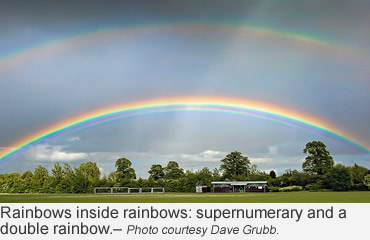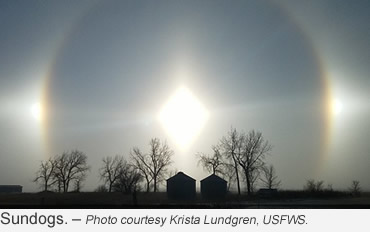What looks like a rainbow but isn’t a rainbow? Perhaps you’ve seen one.
It seems like a rainbow turned upside down. Some folks say that’s God’s Smile, but meteorologists call it a circumzenithal arc or a CZA.
Or, it might look like a rainbow only it is parallel to the horizon. Sometimes poetically called a fire rainbow, that optical phenomenon is actually a circumhorizontal arc.
Oh, wait, there, isn’t that a rainbow, but . . . there are two of them . . . or maybe three stacked together! Wow! Where’s the camera? You’ve just hit the jackpot as a weather sky watcher. Not only have you seen a double rainbow, created when sunlight is reflected twice inside raindrops, but you’ve also seen a supernumerary rainbow, which is a smaller repeating rainbow with lighter colors.
 These interesting things in the sky may appear a bit magical, but they are all explained by meteorological and atmospheric science.
These interesting things in the sky may appear a bit magical, but they are all explained by meteorological and atmospheric science.
What each of these has in common are the seven brilliant colors of the visible spectrum: red, orange, yellow, green, blue, indigo and violet.
What makes them different is the path light takes as it is bent and reflected to create amazingly brilliant colors.
Colors of a rainbow are viewed through raindrops, but circumzenithal and circumhorizontal arc colors are viewed through hexagonal ice crystals found in cirrus or cirrostratus clouds in the upper atmosphere, about 6,000 feet above. The clouds are wispy and feathery in appearance and composed entirely of ice crystals.
 Circumzenithal and circumhorizontal arcs are part of an optical phenomenon family that includes ice halos seen around the sun or moon. Sundogs, another phenomenon often observed during very cold weather, appear as brilliant light patches to the left and right of the sun, and are seen at the same altitude above the horizon as the sun.
Circumzenithal and circumhorizontal arcs are part of an optical phenomenon family that includes ice halos seen around the sun or moon. Sundogs, another phenomenon often observed during very cold weather, appear as brilliant light patches to the left and right of the sun, and are seen at the same altitude above the horizon as the sun.
Circumhorizontal arcs are seen 46 degrees or more below the sun, and parallel to the horizon. The color red is seen in its halo on the uppermost side.
Higher in the sky, looking above the horizon, the circular halo of the circumzenithal arcs’ zenith as its convex center appears about 46 degrees above the sun.
 As with all halos, it can form by the light of the moon or sun, but the moon would be very bright, or a full moon, for the rare lunar circumzenithal arc to make an appearance.
As with all halos, it can form by the light of the moon or sun, but the moon would be very bright, or a full moon, for the rare lunar circumzenithal arc to make an appearance.
However, like rainbows, neither of the arcs are rare, and like rainbows, both make relative brief appearances in the sky, lasting several minutes, and typically long enough to capture by camera.
They can occur anytime during the year, although if you are intent on photographing a sundog, watch for them when the sun is lower on the horizon in January, April, August and October.
You may find beautiful natural events like rainbows, sundogs, moon halos, or brilliantly-hued sky-high or horizontal arcs as something to investigate further, to wait and watch and record.
– Resources: SciJink-NOAA, EarthSkyNews